Butterflies of the Adirondacks:
Mustard White (Pieris oleracea)
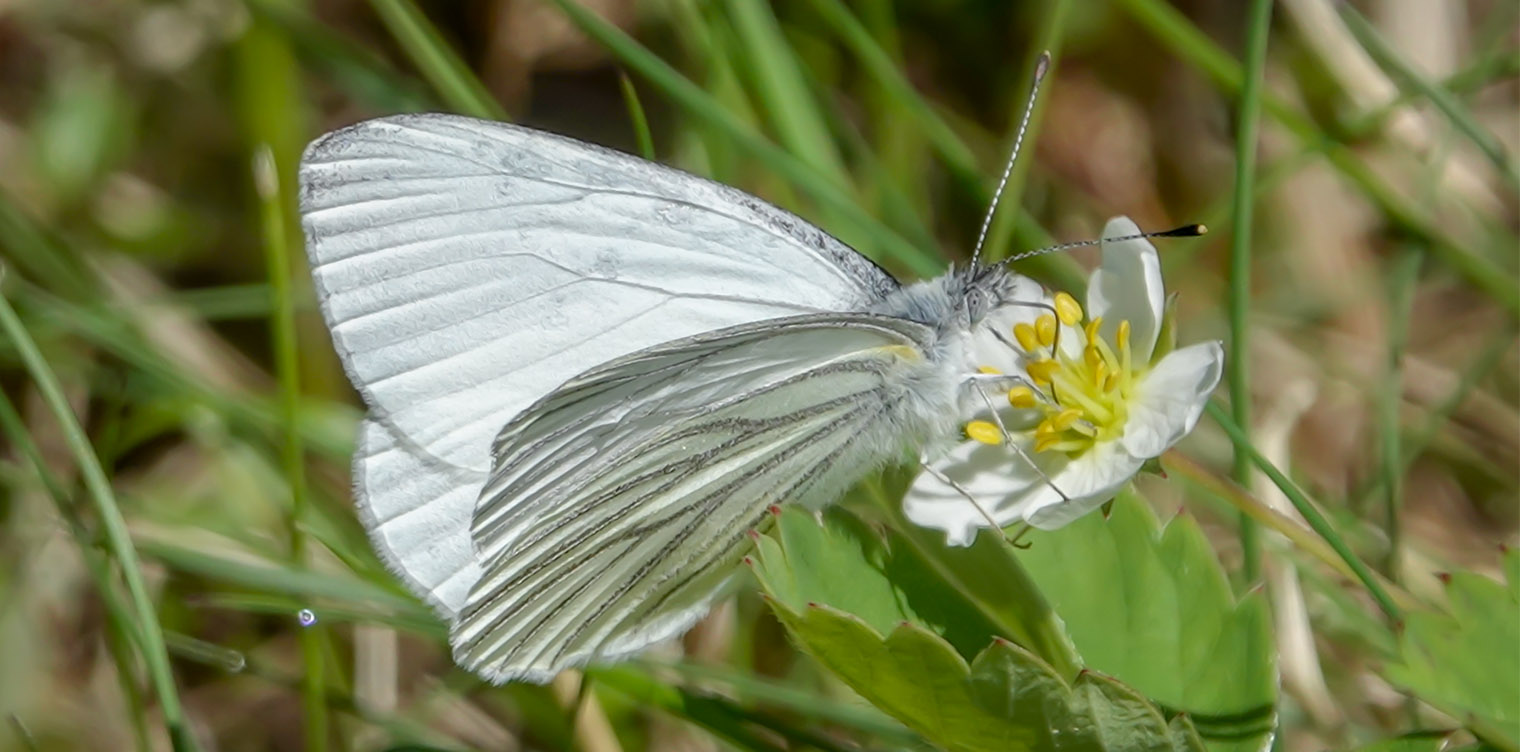
The Mustard White (Pieris oleracea) is a medium-sized, white butterfly found in or near deciduous or mixed forests in the Adirondack Mountains, flying from late spring to late summer.
The Mustard White is a member of the family Pieridae (whites and sulphurs), consisting of about 55 to 60 species in North America. [1] Most species in this family are characterized by fairly rapid and low flight, flitting from flower to flower with short stops for nectar. [2]
There are three subfamilies in the family Pieridae, including two subfamilies with species found in the Adirondack Park. [3]
- The subfamily Coliadinae (Sulphurs) includes the Clouded Sulphur, Orange Sulphur, and Pink-edged Sulphur.
- The Mustard White is part of the subfamily Pierinae (Whites), which also includes the more abundant Cabbage White.
Specialists disagree on the how to categorize the Mustard White. It was once thought that the Mustard White and related species were one species, part of what was referred to as the Pieris napi complex (an Old World species). [4] [5] Many sources refer to the Mustard White as Pieris napi or Pieris napi oleracea. [6] [7] [8] Later studies, using using enzyme electrophoresis to measure genetic similarity among populations, have concluded that there are three species in the napi complex, including the Mustard White. [9]
Mustard White: Identification
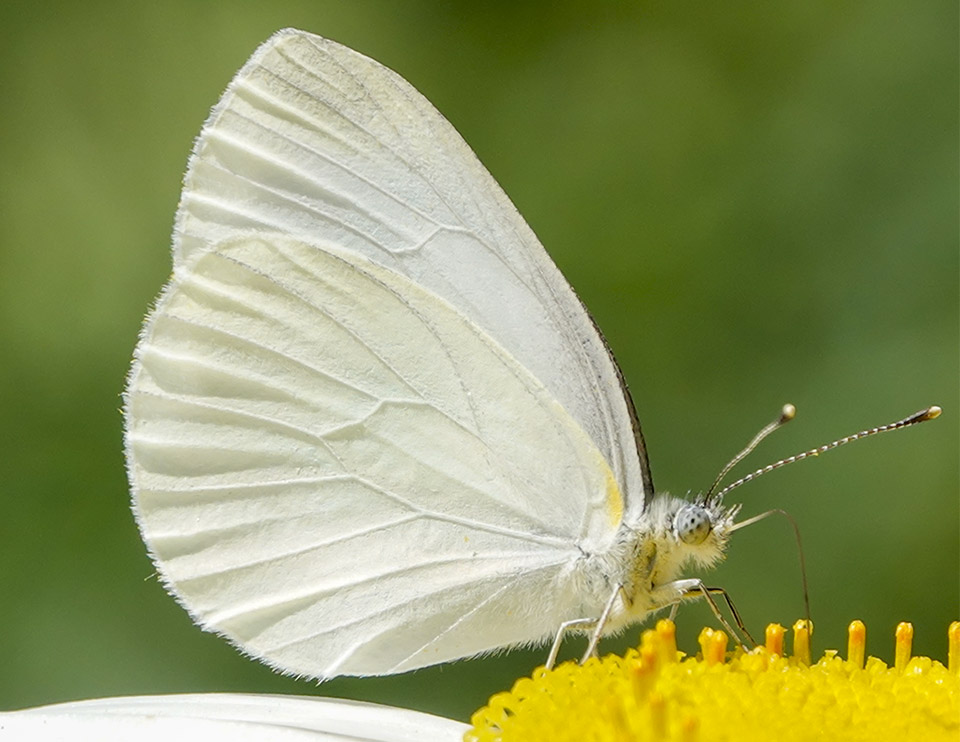
Adult Mustard Whites are a medium-sized butterfly. With a wingspan of 1⅜ to 2¼ inches, the Mustard White is smaller than a Monarch or Canadian Tiger Swallowtail, but larger than an Eastern Tailed-Blue. [10] [11] The eyes are a light bluish-gray.
The Mustard White has two seasonal forms: spring and summer. [12]
- Both forms are chalky white above (the dorsal surfaceDorsal surface: The top side of a wing. ), with a light dusting of black scales at the base of the wings, along the the upper edges of the wings (costaCosta: The upper edge of both the fore wing and the hind wing.), and at the apex of the fore wing. [13]
- The underside (ventral surfaceVentral surface: The underside of a wing. ) of the spring form has pale yellow on the hind wing and near the apex of the fore wing. In addition, the veins are lined with contrasting dark shading. [14]
- The summer form is white above and below. The underside has little or no dark shading on the veins. [15]
The other white butterfly commonly seen in the Adirondacks is the Cabbage White, which is about the same size as the Mustard White. The two species can be easily confused from a distance, but there are several distinguishing characteristics The spring form of the Mustard White can be distinguished from the Cabbage White by the presence of the dark shading on the veins. The Cabbage White, which flies at that time, lacks the prominent dark shading of the Mustard White.
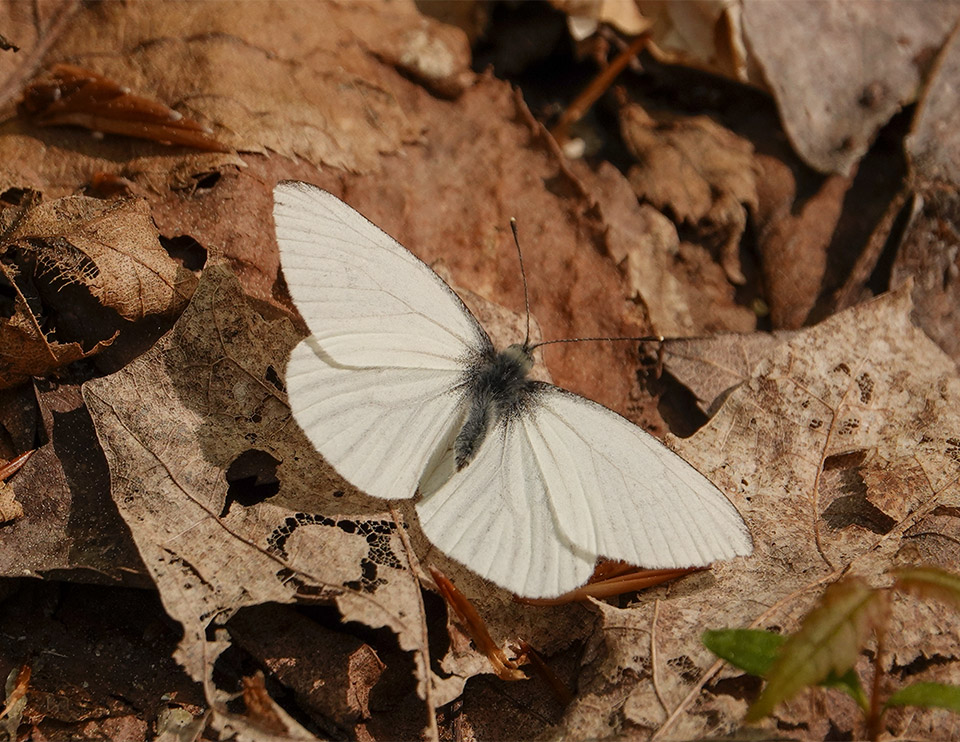
In addition, the Cabbage White has a charcoal-black patch on the fore wing that the Mustard White lacks. Female Cabbage Whites have two submarginalSubmarginal: Just inside the outer margin (edge) of the wing. black spots on the upper side of its fore wing, while the male has one. The Mustard White, by contrast, lacks black markings on the upper side of its wings. [17]
Distinguishing the Mustard White from the closely-related West Virginia White is more difficult, since this species (which was once thought to be the same species as the Mustard White [18] ) also has vein markings on the hind wing. However, the shading on the veins of the West Virginia White's wings is gray-brown, rather than the dark green of the Mustard White. Moreover, the fore wings of the West Virginia White are slightly rounded, in contrast to the more pointed fore wings of the Mustard White. [19] [20] [21]
In any event, the West Virginia White is less common than the Mustard White. [22] There are no confirmed sightings of West Virginia Whites in the Adirondack Park on the Butterflies and Moths of North America data base.
The eggs of the Mustard White are white to greenish-yellow and spindle shaped. [23] The caterpillar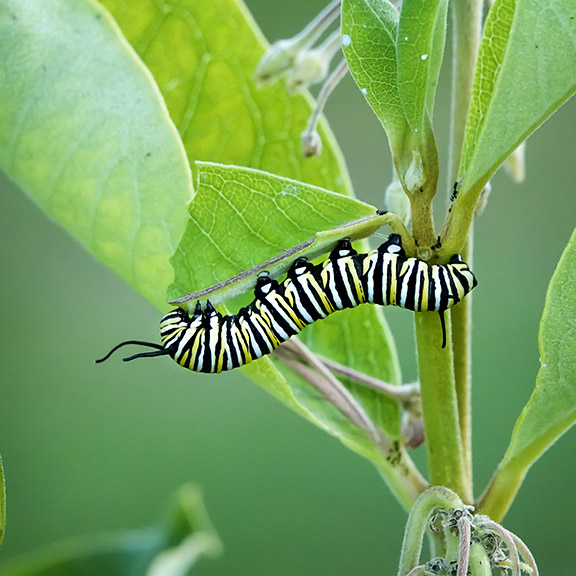 Caterpillar: Butterflies and moths develop through a process called metamorphosis, which entails four states: eggs, caterpillar (larva), pupa, and adult. The caterpillar, representing the second state in the life cycle, hatches from the egg. Its primary activity is eating. The caterpillars first eats its eggshell and then begins consuming the leaves on which the egg was laid. Newly-born caterpillars are very small and expand as they start growing. Because the exoskeleton does not stretch, the caterpillar grows by molting (shedding its skin). The stages between larval molts are called instars. of the Mustard White is green with black dots and a lateral yellow stripe along each side. [24] [25] [26] It is similar to the caterpillar of the Cabbage White, but lacks the yellow dashes. [27] The chrysalisChrysalis: The hard outer shell of a pupa. of the Mustard White is said to be light brown to blue-gray or green. [28]
Caterpillar: Butterflies and moths develop through a process called metamorphosis, which entails four states: eggs, caterpillar (larva), pupa, and adult. The caterpillar, representing the second state in the life cycle, hatches from the egg. Its primary activity is eating. The caterpillars first eats its eggshell and then begins consuming the leaves on which the egg was laid. Newly-born caterpillars are very small and expand as they start growing. Because the exoskeleton does not stretch, the caterpillar grows by molting (shedding its skin). The stages between larval molts are called instars. of the Mustard White is green with black dots and a lateral yellow stripe along each side. [24] [25] [26] It is similar to the caterpillar of the Cabbage White, but lacks the yellow dashes. [27] The chrysalisChrysalis: The hard outer shell of a pupa. of the Mustard White is said to be light brown to blue-gray or green. [28]
Mustard White: Life History
Male Mustard Whites patrol throughout the day in search of receptive females, with most mating taking place around midday. [29] [30] Female Mustard Whites lay eggs singly on the undersides of host plant leaves. [31] The host plants, on which the caterpillars Caterpillar: Butterflies and moths develop through a process called metamorphosis, which entails four states: eggs, caterpillar (larva), pupa, and adult. The caterpillar, representing the second state in the life cycle, hatches from the egg. Its primary activity is eating. The caterpillars first eats its eggshell and then begins consuming the leaves on which the egg was laid. Newly-born caterpillars are very small and expand as they start growing. Because the exoskeleton does not stretch, the caterpillar grows by molting (shedding its skin). The stages between larval molts are called instars. feed by boring into the leaves, are a variety of plants in the mustard family (Brassicaceae), [32] mainly native species, such as Two-leaved Toothwort (Cardamine diphylla), [33] Cuckoo Flower (Cardamine pratensis), and Rock Cress (Arabis pycnocarpa). [34] [35]
Caterpillar: Butterflies and moths develop through a process called metamorphosis, which entails four states: eggs, caterpillar (larva), pupa, and adult. The caterpillar, representing the second state in the life cycle, hatches from the egg. Its primary activity is eating. The caterpillars first eats its eggshell and then begins consuming the leaves on which the egg was laid. Newly-born caterpillars are very small and expand as they start growing. Because the exoskeleton does not stretch, the caterpillar grows by molting (shedding its skin). The stages between larval molts are called instars. feed by boring into the leaves, are a variety of plants in the mustard family (Brassicaceae), [32] mainly native species, such as Two-leaved Toothwort (Cardamine diphylla), [33] Cuckoo Flower (Cardamine pratensis), and Rock Cress (Arabis pycnocarpa). [34] [35]
Adult Mustard Whites reportedly prefer the nectar from their host plants, but are also seen nectaring on other plants. [36] Examination of photos of Mustard Whites in the Adirondack Park reveal a wide range of adult nectar sources, including Two-leaved Toothwort, Spreading Dogbane, Common Dandelion, Bird Vetch, and Common Wild Strawberry. [37] [38]
Mustard Whites from the spring brood reportedly restrict much of their activities to woodlands. Those emerging later in the summer are more often found in open areas. [39]
Mustard Whites reportedly overwinter as chrysalidsChrysalid: Refers to being in the pupa stage, enclosed in a cocoon, before turning into a butterfly or moth.. [40] Most chrysalids from the second brood and all from the third brood are said to enter diapauseDiapause: A period of inactivity and reduced physiological function, usually triggered by environmental cues, like changes in daylight, temperature, or food availability. More commonly occurs in caterpillars or chrysalises. (a period of reduced activity) and overwinter. [41]
Mustard White: Habitat and Range
The range of the Mustard White covers the northern tier of the US, from North Dakota east to Maine. [42] In Canada, it is found from Newfoundland west to the Rocky Mountain foothills in Alberta, northern and central British Columbia, and the western Northwest Territories to the treeline. [43]
Most sources agree that the Mustard White has declined in abundance throughout much of its range in the northeast, apparently since the mid-19th century. [44] [45] The species is currently listed as Threatened in Massachusetts. [46]
- One possible explanation for the decline is that it stems from competition with the Cabbage White, which was accidentally introduced to North America from Europe sometime in the mid-1800s. [47]
- Another explanation is that the decline of the Mustard White, at least in some areas, was due to loss of habitat, as woodlands were converted to agricultural uses. [48]
- An alternate explanation is that the Mustard White's decline has been due to the spread of nonnative mustard plants, such as Garlic Mustard (Alliaria petiolata). Female Mustard Whites are attracted to these alien mustards and will lay their eggs on them, but the caterpillars cannot complete their development on these hosts. By contrast, the larvae of Cabbage Whites, which also make use of the introduced plants, are able to thrive on them. [49] Some experiments suggest that the Mustard White may be adapting to the alien Garlic Mustard. [50]
- Yet another explanation for the Mustard White's decline in some areas is that the wasp parasites that were introduced to combat Cabbage Whites in agricultural fields were also effective in eliminating the Mustard White from much of its former range. [51] [52]
It is not clear if the declines seen in other parts of the Mustard White's range have also affected Adirondack populations of Mustard Whites.
In terms of habitat, the Mustard White is characterized as a medium generalist. [53] It is seen as primarily a woodland butterfly, favoring deciduous woods and nearby open areas, [54] [55] [56] [57] but it can also be found in mixed woods, conifer forests, bogs, open fields, streamsides, and roadsides. [58] [59 [60] [61]
Mustard White: Flight
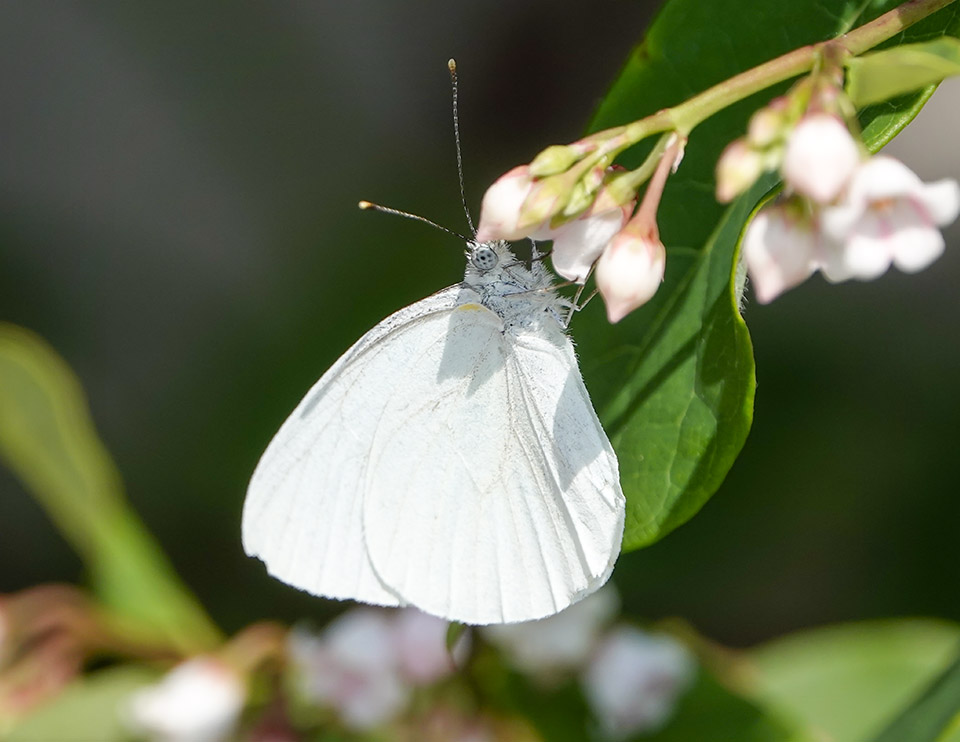
The flight period of Mustard Whites, as with all butterflies, varies with region and probably shifts from year to year. Throughout its range, the Mustard White is said to have two overlapping generations in most areas: from late April through mid-June, and from early July through August. [62] [63]
- In Wisconsin, the Mustard White is said to have two broods, the first flying from late April through early June and the second flying from July to early August. [64]
- There are three broods in Massachusetts with flight periods from mid-April to mid-June, mid-July, and from the second week of August to mid-September. [65] [66]
- In Vermont, there are two to three generations, flying from late April to mid-September. [67]
- In Canada, Mustard Whites are seen from late April to mid-September, with two overlapping generations. In the northern parts of their range, Mustard Whites have only one brood in June and July, while in southern Ontario there are three (occasionally four) generations. [68]
The flight period and abundance of the Mustard White within the Adirondack Park can only be roughly estimated, based mainly on a very limited number of verified sightings on Butterflies and Moths of North America (BAMONA) and reported observations on iNaturalist.
- The advantage of iNaturalist is that it is a popular citizen science web site that attracts many observers, in part because it covers both plants and animals (making it easy for people to record all of their observations in one place) and in part because the process of submitting an observation is very easy. The disadvantage is that an individual observation can achieve "research-grade" status by having the identification confirmed by the observer and one additional individual, who may or may not have expertise in that particular taxon.
- The advantage of BAMONA is that sightings are verified by regional specialists who are recognized experts. The disadvantage is that there are fewer sighting records for most species, partly because the site covers only butterflies and moths and partly because the process of submitting a sighting is more time-consuming.
- Both data sets share a common problem of citizen science: reported trends may reflect trends in the number of observers and their willingness to submit reports, not the abundance of the butterfly in question.
With these caveats in mind, it appears that Mustard Whites are on the wing in the Adirondack Park from at least late May through late August.
- Mustard Whites have been intermittent guests at the Paul Smith's College VIC Native Species Butterfly House, which collects its butterfly and moth residents from the immediate area. [69] Mustard Whites were logged as present in the Paul Smith’s VIC Butterfly House 30 times in 2012, with dates ranging from the end of June to late August. This species represents one of the more frequent guests in the Butterfly House, but much less frequent than the related Cabbage White, which was logged as present 79 times, the Monarch at 82, and the Atlantis Fritillary at 83. Logbooks from 2013, 2015, and 2016 indicate that the Mustard White was present intermittently from late June to late August.
- BAMONA lists 27 verified sightings of Mustard Whites in New York State; 20 are in the Adirondack Park. The Adirondack sightings range from late May through late July. [70]
- There have been 26 research-grade observations of adult Mustard Whites within the Adirondack Park Blue Line in iNaturalist. [71] This compares to the 571 research-grade observations within the Adirondack Park for the most popular and abundant butterfly: the Monarch. The observations for the Mustard White extend from late May through late July. [72] [73] [74] [75] [76] [77]
References
- Susan Grimm Hanley. Interpretive Naturalist, Paul Smith's College Native Species Butterfly House. Species Logbooks.
- Butterflies and Moths of North America. Species Profiles. Mustard White. Pieris oleracea. Retrieved 22 May 2022.
- Butterflies and Moths of North America. Sighting Records. Mustard White. Pieris oleracea. 7/19/2014, 7/19/2014, 5/27/2015, 5/23/2018, 7/9/2018, 5/31/2019, 5/31/2019, 5/31/2019, 6/6/2019, 6/8/2019, 7/20/2019, 7/24/2019, 7/27/2019. Retrieved 22 May 2022.
- Butterflies and Moths of North America. Family Pieridae. Whites and Sulphurs. Retrieved 22 May 2022.
- iNaturalist. Adirondack Park Sightings. Mustard White. Pieris oleracea. Retrieved 22 May 2022.
- iNaturalist. Adirondack Park Sightings 2016. Mustard White. Pieris oleracea. Retrieved 22 May 2022.
- iNaturalist. Adirondack Park Sightings 2017. Mustard White. Pieris oleracea. Retrieved 22 May 2022.
- iNaturalist. Adirondack Park Sightings 2018. Mustard White. Pieris oleracea. Retrieved 22 May 2022.
- iNaturalist. Adirondack Park Sightings 2019. Mustard White. Pieris oleracea. Retrieved 22 May 2022.
- iNaturalist. Adirondack Park Sightings 2020. Mustard White. Pieris oleracea. Retrieved 22 May 2022.
- iNaturalist. Adirondack Park Sightings 2021. Mustard White. Pieris oleracea. Retrieved 22 May 2022.
- iNaturalist. Adirondack Park Sightings. Monarch. Danaus plexippus. Retrieved 22 May 2022.
- Government of Canada. Canadian Biodiversity Information Facility. Species Bank. Mustard White. Pieris oleracea. Retrieved 2 December 2019.
- Government of Canada. Canadian Biodiversity Information Facility. Species Bank. West Virginia White. Pieris virginiensis. Retrieved 2 December 2019.
- Massachusetts Butterfly Club. Massachusetts Butterfly Species List. Mustard White. Pieris napi. Retrieved 2 December 2019.
- Massachusetts Audubon. Butterfly Atlas Species Accounts. Mustard White. Pieris napi. Retrieved 2 December 2019.
- The Butterflies of Massachusetts. Mustard White. Pieris oleracea. Retrieved 4 December 2019.
- McFarland, Kent P. and Bryan Pfeiffer. Vermont Butterfly Survey. Vermont Center for Ecostudies – Vermont Atlas of Life. Mustard White. Pieris oleracea. Retrieved 4 December 2019.
- Integrated Taxonomic Information System On-line Database. Pieris oleracea. Retrieved 4 December 2019.
- Iowa State University. Department of Entomology. BugGuide. Mustard White. Pieris oleracea. Retrieved 4 December 2019.
- Wisconsin Butterflies. Common Name. Mustard White. Pieris napi. Retrieved 4 December 2019.
- Ross Layberry, Peter Hall, and Don Lafontaine. The Butterflies of Canada (University of Toronto Press, 1998), p. 91, Plates 6, 31.
- Thomas J. Allen, Jim P. Brock, James P. Brock, Jeffrey Glassberg. Caterpillars in the Field and Garden: A Field Guide to the Butterfly Caterpillars of North America (Oxford University Press, 2005), pp. 36-37.
- David L. Wagner. Caterpillars of Eastern North America: A Guide to Identification and Natural History (Princeton University Press, 2010), p. 84.
- National Audubon Society. Field Guide to Butterflies (New York: Alfred A. Knopf, 1981), p. 350. Retrieved 5 December 2019.
- Jeffrey Glassberg. Butterflies of North America (Sterling Publishing Company, 2011), pp. 70-71.
- Jeffrey Glassberg. Butterflies through Binoculars. The East. A Field Guide to the Butterflies of Eastern North America (Oxford University Press, 1999), pp. 51, 53, Plate 6.
- Jeffrey Glassberg. A Swift Guide to Butterflies of North America. Second Edition. (Princeton University Press, 2017), p. 41.
- Jim P. Brock and Kenn Kaufman. Kaufman Field Guide to Butterflies of North America (Houghton Mifflin, 2003), pp. 46-47.
- Paul A. Opler. A Field Guide to Eastern Butterflies (The Peterson Field Guide Series, Houghton Mifflin Company, 1992,1998), pp. 50-51, 58-59, 147-149. Retrieved 5 December 2019.
- James A. Scott. The Butterflies of North America. A Natural History and Field Guide (Stanford University Press, 1986), pp. 217-219, Plates 2, 9. Retrieved 5 December 2019.
- Paul A. Opler and George O. Krizek. Butterflies East of the Great Plains: An Illustrated Natural History (The Johns Hopkins University Press, 1984), pp. 57-58, Plate 6.
- Rick Cech and Guy Tudor. Butterflies of the East Coast. An Observer's Guide (Princeton University Press, 2005), pp. 77-79. Retrieved 22 May 2022.
- John Eastman. The Book of Swamp and Bog: Trees, Shrubs, and Wildflowers of Eastern Freshwater Wetlands (Stackpole Books, 1995), pp. 199-200.
- John Eastman. The Book of Forest and Thicket: Trees, Shrubs, and Wildflowers of Eastern North America (Stackpole Books, 1992), pp. 190-191.
- John Eastman. The Book of Field and Roadside: Open-Country Weeds, Trees, and Wildflowers of Eastern North America (Stackpole Books, 2003), pp. 7-9, 197-202, 240-242.
